Living Simply
- Rainwater harvesting with swales and barrels
- Recognizing and using all the contributions and yields of animals: chickens, guineas and more
- The design and benefits of a greenhouse-chicken coop
- Integrated Systems
- cooperation rather than competition
- each element serves many functions
- each function supported by many elements
- Small scale, self replicating systems
- use of local resources
- maximum use of minimum resources
- Energy Storage
- natural storage in water, soil, and trees
- storage in buildings and infrastructure
- Recycling of Materials
Loretta Missing
I’ve not seen her since Friday night. This is only the second time she has not returned. The first time she did not show up for a day. Given that it’s been three days I’m guessing she has flown away or gotten hurt, hopefully the first. I don’t know much about their habits other than what I’ve seen. The only thing that has changed is that the lake was frozen for a couple days. Perhaps that would be enough for her to leave? I had not expected that though.
I’m really bummed about it. I suppose I knew this day would come sooner or later but that doesn’t really make it any easier. I find myself looking down at the lake constantly hoping I’ll see her. Ugh.
Wood Stove Thermal Mass Update
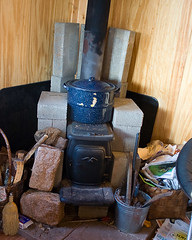 First, a bit of background for those not familiar with the construction details of my cabin. It is standard 2x4 walls with R-13 insulation, R-19 in the ceiling and inside walls finished with plywood beadboard. While the floor is not properly insulated I did very carefully stuff MANY layers of bubble wrap in this fall with rolled wrap tightly stuffed into each end to block the wind. It’s not real insulation but I’m certain that there is FAR less wind and air movement under the space that had previously been open. The bubble wrap was not purchased but re-used from Greg’s shutter business. I’ve also got stacked rock along the base of the cabin from ground up a couple inches past the outer 2x8 rafter.
First, a bit of background for those not familiar with the construction details of my cabin. It is standard 2x4 walls with R-13 insulation, R-19 in the ceiling and inside walls finished with plywood beadboard. While the floor is not properly insulated I did very carefully stuff MANY layers of bubble wrap in this fall with rolled wrap tightly stuffed into each end to block the wind. It’s not real insulation but I’m certain that there is FAR less wind and air movement under the space that had previously been open. The bubble wrap was not purchased but re-used from Greg’s shutter business. I’ve also got stacked rock along the base of the cabin from ground up a couple inches past the outer 2x8 rafter.
For this winter I stacked concrete blocks around my wood stove with excellent results thus far. I’ve got a total of 24 solid blocks (3.5" x 7.5" x 15.5"). They’re stacked on the the two long sides and behind the stove and up about 2.5 feet on the back side of the stove pipe. On the sides I’ve got them stacked two thick (about 7"). On top I’ve got a big enamel canning pot full of water which leaves just enough room on the stove top to put my coffee pot. I also reinforced the floor deck under this corner of the cabin using a couple concrete blocks placed snuggly under the floor rafters.
I’m finding that I can do two very distinct fires, morning and late evening. Thus far each fire is 3-5 logs for a fairly hot burn of 1.5 to 2.5 hours. The result is that the concrete blocks moderate the hottest peak of the burn because they are of course absorbing lots of heat. About an hour after the fire has burned out the heat finally really makes it’s way to the outer edges of the concrete. They are hot to the touch but by no means hot enough to burn anything. I type this at 3:15pm and the blocks and pot of water are still noticeably warm. My morning fire was over at 8:15am -that’s seven hours of steady, slow warmth. I expect that they’ll radiate heat for another hour, maybe two before diminishing. A huge improvement. Rather than peaking at 85 (or higher!) and fairly quickly dropping to 60 I’m peaking at about 80 and VERY slowly dropping. In fact, there is a moderation of temps even past the time that the blocks feel warm. I’m going out this evening and won’t be back till 9pm to rekindle the fire but if the past week is any indication the cabin will still be at 60 or above at that time… 12 hours past the morning fire. Outside temps today: 30 at sunrise, 40 at 3:30pm. Inside temps today: 60 at sunrise, 68 at 3:30pm. I’ve just started keeping track 9 days ago and in that time I’m seeing an average difference of about 22 degrees at sunrise and sunset before the morning or evening fire is built.
My guess is that in the colder part of winter when nights regularly dip to 20 or less and highs only in the lower 30s that I’ll be burning my morning and evening fires longer with more logs but I’m hoping that each fire will still be fewer than 10 logs. Based on what I’ve seen thus far I don’t think it is unrealistic to estimate that I’ll burn about 40-50% less wood than last year. I wish I’d thought to keep track last year with no blocks so that I could compare by numbers rather than memory of numbers. I routinely heated myself out of the cabin. It would warm very quickly but also cool fairly quickly, especially at night. Each day I’d try to get the fire up then let it go to very low coals and re-ignite. At night I’d try to keep the fire going till bed at midnight when I’d stock it up as much as I could without getting it too hot to sleep. If I failed to wake up at 2 or 3 am to get it going again I regularly woke to 40 degrees, sometimes less on really cold nights. Constantly up and down.
Regardless of how much wood I save I know for certain that the less extreme temperatures and warmer mornings will greatly increase my comfort level as well as the time I spend tending the fire. Well worth the $52 spent on concrete blocks! This is not even close to an original idea. There are many variations on the concept. Masonry stoves, cob…. the important thing is to have as much thermal mass around your stove as you can afford and safely place on the floor. If I had planned better I would have built this section of floor much stronger and would have 40 or 50 blocks rather than 24. In that case I’d often be able to get by with just one fire a day, burning it a bit hotter and longer and coasting for longer. The more mass the better the moderating of temps. The greenest choice would be a cob covered rocket stove. If I’d known of those when we started I probably would have gone that route.
Update: Last night got cold! Outside temp at 7am was 18 which I consider the first real test. Inside the bricks and water were still quite warm and it was 62 in the cabin. The fire did go late though as I got in late. Fire from 10pm with a big bed of coals at 1am, 7 logs burned. I’m VERY happy with this. I know from last year that a fire ending at 1am, with 18 degrees outside would have meant a morning just above 40 with NO residual heat from the stove. On a typical night though I’ll probably start my evening fire 2-3 hours earlier which will likely mean that the fire dies down at 11pm and the morning temp will be closer to 58ish. Still, a fantastic improvement!
Technorati Tags:
Cabin, Carbon, Climate Change, Conservation, Energy, Energy Conservation, Global Warming, Homesteading, Living Simply, Natural Resources, Self Reliance
Taking of Life
Deer hunting is in full swing these days. Last weekend my brother and uncle both shot deer. The taking of life is something I’ve been thinking about lately. A month ago I wrote about the two dogs I had to kill. I’ve thought about them off and on since that day and last weekend went to see their decaying bodies where I put them under a couple of trees. They are returning to nature and in that I find a bit of comfort. Nothing in nature is wasted. I don’t have a problem with death. It is inevitable and beautiful in its own way. We all return.
I suppose what I have a problem with is the unnecessary taking of life. When we butchered three of the roosters back in September I was okay with that because it really needed to be done. I’ve been catching and eating fish out of the lake over the past year and I’m okay with that because I know there are GOBS of fish in the lake. Harvesting fish and chickens when necessary for management I can deal with. Harvesting deer I can deal with because I know there are lots of them and they are an excellent source of local protein. I’ve been thinking that I might hunt a few rabbits or squirrels this winter because there are lots of them here. LOTS. I’m not sure I’ll do it though it fits into my plan of more local protein via very select harvesting of a variety of animals.
I have a block in my brain. I imagine a deer, rabbit, or squirrel going about its business of living. I imagine in vivid detail that rabbit in all it’s fuzzy adorableness and then I imagine its life coming to a sudden and violent end not by owl or fox but by a bullet. I know, rationally that death is a part of nature and as I said above, I embrace that cycle of life. Nature is organisms consuming one another, the constant movement of energy through consumption and digestion. I also know that local protein from a rabbit or squirrel is a healthy way for me to obtain protein. The alternative is to continue importing it from offsite in the form of a variety of beans, rice and other vegetable sources. I’m fairly certain that the most ecologically sustainable protein would be the local meat especially when it is actually on site.
I think I know that the most natural, energy efficient way for me to sustain my body is to strive for local food which means gardening and hunting. Because vegetable protein is so easily available at the grocery store I’ve allowed myself to view hunting as optional, unnecessary. I don’t NEED to hunt to survive. But the truth is that if I don’t make an effort to get food by hunting (and gardening) I’ll continue relying on imported energy from the grocery store which means thousands of food miles from who knows where. Of course, there is the looming economic depression which IS coming regardless of any can kicking by the Obama folks. Of course here is also peak oil and crazy weather, both of which will impact food production in the short and long terms. My point is that right now conditions permit that I can think and debate this with myself but the time may not be far off where I am forced to hunt by disruptions in the food supply. And I do believe that day is coming, sooner rather than later.
A part of my problem is a constant sense of guilt. I’ve gotten into the pattern of trying to offset what I deem to be the “bad” behavior of other people. Whether it is climate change or industrial agriculture’s method of meat production, the more I see others around me showing a lack of concern the more determined I am. The result is that I am very sensitive to the possibility that I might drive a car unnecessarily which is a direct response to seeing so many others show no care at all in their use of oil or coal. Quite honestly, I went through a couple years of pretty intense depression. I was so frustrated, angry, sad at my perception that most people don’t care about the impact of their lives that I wanted to end my own. I just shut down. Stopped going out in public. Stopped visiting family. Not only did I not want to get in a car but I often did not even want to eat. I wanted to crawl into the crook of big tree and fade away. When I moved to the cabin I had not planned on connecting to people again. I figured I’d find what little happiness I could alone in a garden and little cabin by the lake.
Back to my point, I think my reluctance to eat meat is a direct response to living in a country/culture where eating meat is just an accepted part of life. Most people I’ve ever known don’t really care about the welfare of the animals they eat and any kind of cruelty those animals may have endured before being butchered is simply a non-issue to them. You can see where this is going. My response has been to develop a very deep emotional connection to the animals around me. Whether it is a tufted titmouse, canada goose, white-tail deer, swallowtail butterfly or any of the critters around me, I respect their existence. How can I not? I’m struggling to reconcile this respect for the individuals with my understanding that in a healthy, natural ecosystem some animals eat other animals. Humans are animals after all. We are a part of it all. True as that is it is also true that we’ve allowed ourselves to become completely disconnected from what sustains us and with this alienation comes a dangerous ability to disrespect. I think we’ve forgotten that we are, in fact, animals and that we share this planet with many other species. We are just one. We like to think that we’re special because of our “intelligence” and yet I see what we’ve done with it and I can do is shake my head.
We humans, in our grand intelligence, have made war upon one another and upon the planet our way of life. Given this context I’ve made a habit of trying very hard to do no harm. I know that I’ve failed, I’ve done plenty of harm. But that doesn’t mean that I shouldn’t try. In any case, I’ve been thinking about what it means for me to survive and whether or not I’ll start hunting.
Technorati Tags:
Cabin, Chickens, Conservation, Economic Collapse, Economic Depression, Economy, Energy, Energy Conservation, Environment, Environmentalism, Food, Food Production, Foraging, Gardening, Global Depression, Great Depression, Homesteading, Humanity, Living Simply, Natural, Natural Resources, Oil, Peak Energy, Peak Oil, Permaculture, Recession, Self Reliance
Recycled kitchen table and other projects
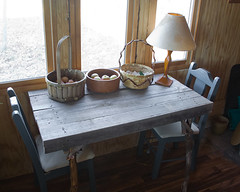 When I first moved into the cabin in May of 2008 I was loaned/given a little kitchen table which, while very functional, didn’t really fit. It was in great shape, like new really, but was an 80’s style particle board deal that just didn’t feel right. I finally got around to making the table that I thought would fit better and I’m pretty happy with it. It is very simple, made of weathered wood from free pallets we picked up this past spring. The old wood and cedar branch legs are a much better fit for the cabin. I had enough wood left over to build a rustic end cabinet between the door and sink as well as a few wall shelves. I’ve still got a few details to finish but they are mostly done and very functional. I’ve still got gobs of wood left so I’m thinking about how I might put it to use.
When I first moved into the cabin in May of 2008 I was loaned/given a little kitchen table which, while very functional, didn’t really fit. It was in great shape, like new really, but was an 80’s style particle board deal that just didn’t feel right. I finally got around to making the table that I thought would fit better and I’m pretty happy with it. It is very simple, made of weathered wood from free pallets we picked up this past spring. The old wood and cedar branch legs are a much better fit for the cabin. I had enough wood left over to build a rustic end cabinet between the door and sink as well as a few wall shelves. I’ve still got a few details to finish but they are mostly done and very functional. I’ve still got gobs of wood left so I’m thinking about how I might put it to use. 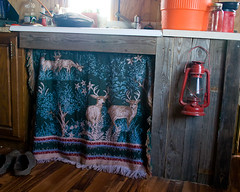
I’ve always been fond of weathered wood and the more I really look at it the more I appreciate it. The texture and color of it seems so much more natural to me as it so closely matches the coloring and texture of the outer bark of most trees. While I like the warmer red tones of new, untreated wood these are not the colors you see when you look out at trees in the forest. You only see these colors when you cut into a tree. 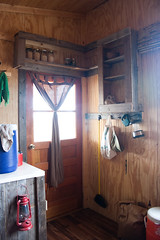
The last big project for my cabin will be a covered porch which I hope to get to in the spring. I’ve still got a few bits of trim that I never put up that I am going to take care of very soon. Eventually I would like to cover the vinyl flooring with some sort of wood flooring but for that I’ll wait till I find something I can salvage and re-use.
Technorati Tags:
Cabin, Living Simply, Natural Resources, Recycling, Reusing, Wood
Adding Thermal Mass for the Wood Stove
 I’ve added 30 concrete blocks around my wood burning stove to add thermal mass for heat storage. Once I’ve decided on the exact configuration and gotten all the blocks in that I want I’ll probably cover it with cob or mortar on some rocks. Does cob adhere well on top of concrete? My only concern with such a covering would be access to the stove should I need to do any maintenance. Still thinking on that. I can report that after burning a couple fires this thermal mass makes all the difference. Granted it has mostly been in the 40s I’m seeing a big difference. I can burn a 3-5 log fire once a day at these temps and the mass stores and releases the heat till the next day. NICE.
I’ve added 30 concrete blocks around my wood burning stove to add thermal mass for heat storage. Once I’ve decided on the exact configuration and gotten all the blocks in that I want I’ll probably cover it with cob or mortar on some rocks. Does cob adhere well on top of concrete? My only concern with such a covering would be access to the stove should I need to do any maintenance. Still thinking on that. I can report that after burning a couple fires this thermal mass makes all the difference. Granted it has mostly been in the 40s I’m seeing a big difference. I can burn a 3-5 log fire once a day at these temps and the mass stores and releases the heat till the next day. NICE.
My guess is that when we dip into real winter temps I’ll be able to burn a morning and evening fire, each 4-6 logs and coast the rest of the time. If that works out it would be a reduction of about 70% from last year! Not only that but the burn time is short and hot which means much more efficient. No more throttling down the burn to control the temp and lengthen the burn time all of which means more pollution. Much less smoke and much less work chopping wood! Not only that but I’ll wake up in the morning to a cabin it 60 or 65 degrees rather than 40 or 45 as was the case many mornings last winter.
Technorati Tags:
Cabin, Carbon, Climate Change, Conservation, Energy, Energy Conservation, Homesteading, Living Simply, Natural Resources, Permaculture, Self Reliance, Woodburning Stove
I Shot Two Dogs
This was initially written as an article for the Madison County Crier but we ended up printing it as a letter to the editor. This is the ugly side of homesteading with chickens and other animals.
The title for this article says it all. I won’t be talking at about permaculture this week but, rather, the issue of keeping animals safe from other animals and what that sometimes means. In my 40 years on this planet I’ve tried to live a life of respect. For me that means being respectful of life in a general way. The taking of a life should never be done without good reason and absolute necessity. For example, while most people I know think nothing of squishing a spider in their home I’ll catch them and put them outside first. If they are no threat to me I see no reason to end their existence. Another example, I was a vegetarian from 1989 till 2003 and I’ve only eaten fish on a few occasions since 2003. Since living at my homestead I decided that I would begin eating a small amount of local meat, specifically fish from our lake and the occasional problem rooster from our flock of chickens. Last week I also ate a small serving of deer which my brother hunted last year from this land. I’m mentioning all this to make the point that I’ve thought about my diet a great deal and have tried to be respectful of other living things with which I share this planet. My decision to include small amounts of meat in my diet is based upon the understanding that in terms of climate change and energy consumption it makes more sense to eat local meat than it does to rely on vegetable sources of protein that are shipped in from hundreds or thousands of miles away.
Now, about these dogs. On this little homestead I keep chickens, guineas, a goose, a cat and a dog. These are animals that I take care of on a daily basis and I take the responsibility seriously. I feed and water them and keep their housing clean, comfortable and safe from predators. In return they provide me with eggs, manure, and good company. I’ve dreaded the day that free ranging dogs would show up at our place and hoped that when the time came I’d be here to deal with it. Previous to my keeping the chickens we’d had dogs show up but I ran them off with lots of yelling and stick banging. They’d often be back the next day and I’d repeat the process but I was not too worried as my dog stays inside unless I’m out with her. Since getting the birds this past spring I’ve heard many dogs, sometimes nearby but luckily enough they stayed clear of our place. It was not until the past couple weeks that a couple of beagles started coming into the homestead. This week I returned from a morning in town to find the dogs in front of my cabin. The chickens were still in their securely fenced area and I rounded the two dogs up and took them to our gate almost a mile away. I waited a bit and when the dogs did not show I let the critters out. Of course it was not long after that they did show up and were chasing one of the animals. I jumped between them and caught the female and tied her up to a tree. I caught the male a couple minutes later and I tied him up as well.
I spent the following day trying to find someone to take the dogs. After phone calls to two shelters, a vet and a variety of friends and family I had found no one able to take them. Today I loaded the .22 and went out to shoot them. My stomach churned as I put the scope to my eye and the crosshairs on the head of the female. I pulled the trigger and it was finished. Moments later the male was also dead. Killing any animal is difficult for me. Killing a dog was gut wrenching.
What else could I do? I cannot possibly afford to take on another dog, certainly not two. My experience with free range dogs is that they come back over and over. Releasing these two would have likely been a trade for the life of one or more of my animals within a day or two. I fully expect that I will have to do this again. And again. And again. Is there an alternative? Please, if there is I’d like to know about it. I do not want to ever shoot another dog. Ever. That said I have a right and responsibility to defend the animals in my care. One suggestion I’ve received is to take them somewhere else and drop them off but how is that a solution? Then they’ve just become someone else’s problem.
What I cannot grasp is that so many people purposely let their dogs roam the countryside. Americans claim to value freedom but I fear that too many have forgotten that the other side of that coin is responsibility. I wonder if anyone can explain to me how anyone who keeps dogs but lets them run free day after day knowing that they are off to others’ properties is in any way behaving responsibly. My guess is that the people that do this simply don’t care what their dogs are doing. I cannot express how deeply I resent being put into a situation where I have to make this kind of decision and take this kind of action.
These two dogs will never go home and I wonder will they be missed? It disgusts me that I had to take life for no reason other than human stupidity. When we butchered three of our roosters I was okay with that because we needed to do it and I knew that they would be providing healthy meals to our family. There was purpose in it and the meat would be eaten. Whether by training or instinct, these two dogs were simply doing what many dogs do when allowed to run and are guilty of nothing other than being dogs. Quite frankly, people that intentionally let their dogs run loose should not only not be allowed to keep animals they should also be fined or be incarcerated. Letting dogs run loose not only puts them at risk at being run over but also leads to the loss of wildlife and livestock. To put it simply it is criminal behavior and it should not be tolerated.
Technorati Tags:
Chickens, Deer, Ecology, Homesteading, Living Simply, Self Reliance
Sunrise
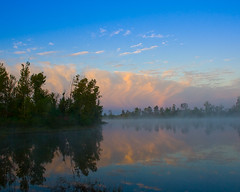
We had a really nice moonset and sunrise the other day. The moon was full and very bright which woke me up as it was shining through my front windows and into my face. While I did get a few shots of the moon that were not too bad it was the sunrise images that turned out the best.
Fertility in progress...
 This has been my first summer garden with chickens and those that have followed along know the various issues I’ve had ranging from the size of the flock being too large as well as issues with free ranging chickens doing a bit too much damage to seedlings. Throughout this summer I’ve been experimenting, observing and thinking. Things improved greatly when we cut the flock size down from 25 to 15, the latter being much closer to my original plan. As of a month or so ago I started free ranging the smaller flock with just a bit of fencing to encourage them to stay in one area for most of the day. By evening the range down to the rest of the garden and other areas but by now the original forage area has had time to recover and I’ve also planted white and red clover which is growing nicely. With the expanded forage area they do less damage wherever they are and the positive benefit of the work they do tilling and turning is more of a positive then a negative.
This has been my first summer garden with chickens and those that have followed along know the various issues I’ve had ranging from the size of the flock being too large as well as issues with free ranging chickens doing a bit too much damage to seedlings. Throughout this summer I’ve been experimenting, observing and thinking. Things improved greatly when we cut the flock size down from 25 to 15, the latter being much closer to my original plan. As of a month or so ago I started free ranging the smaller flock with just a bit of fencing to encourage them to stay in one area for most of the day. By evening the range down to the rest of the garden and other areas but by now the original forage area has had time to recover and I’ve also planted white and red clover which is growing nicely. With the expanded forage area they do less damage wherever they are and the positive benefit of the work they do tilling and turning is more of a positive then a negative.
This photo of Irene’s detailing protection from chickens using a grill made from chestnuts branches is a perfect example of one improvised method for adapting to free range chickens and funnily enough I started doing something similar using sticks poked into the ground and big chunks of bark that I gather after splitting wood for winter heating. My food forest looks… how shall I put it? More interesting? Below you’ll see a recent image of the food forest with yarrow, self heal and little purple coneflowers planted around the paw paws and june berries. Also three rhubarbs and three comfrey are planted and growing well. Last, clover and various greens planted in the berm are all doing well.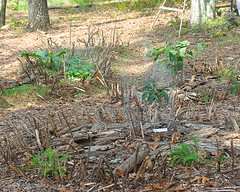
I look around and I see so much organic matter: straw, wood chips, sticks, bark as well as growing fertility such as comfrey, chickory, autumn olives and clover. Then there are the many animal contributions: chickens, guineas, a goose and a deer pooping and scratching and leaving nitrogen rich feathers everywhere. I have little doubt that the fertility of the soil all around the homestead is being greatly increased with all of the new ingredients and activities. Mushrooms and shelf fungi are also sprouting up everywhere which is a good indicator.
I’ve also started the second block in our humanure composting grid. Each block gets one year’s worth of humanure and then sits for an additional 2 years (a total of 3 years) for complete composting. Eventually that compost will be used on the blueberries, juneberries and whatever other fruit bushes and trees we’ve got. My guess is that we could use it sooner but I’m not in any hurry.
It’s been a slow process of fertility building as I never brought in any manure. All of the on site fertility is still in the process of either growing or breaking down from cardboard, newspaper, straw and wood chips. The soil in areas which have had mulch in place since last year are looking greatly improved. As of next spring we will have something like 35 comfrey plants going into their second year which means they’ll be producing quite a bit of fertility.
Technorati Tags:
Chickens, Conservation, Ecological Landscaping, Ecology, Edible Forest Gardening, Edible Landscaping, Food, Food Forest, Food Production, Forest Gardening, Gardening, Homesteading, Living Simply, Mushrooms, Natural, Permaculture, Self Reliance
Loretta
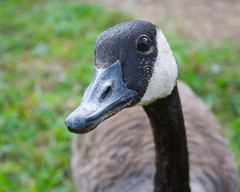 I’m not sure how to say this. I think I’m in love with a goose. Is that strange?
I’m not sure how to say this. I think I’m in love with a goose. Is that strange?
I kid. Really though, she is quite a sweet goose and I am very fond of her. She started hanging out here in early August and has been here every day since. I started calling her Loretta the second or third day she was here. It somehow seemed to fit. She leaves every night to sleep somewhere else, not sure where but she flies off towards the lake and I lose sight of her so my guess is she’s fairly close by. I don’t know where geese prefer to sleep. In any case, she is here most of the day and the little darling has stolen my heart. She follows me around when I’m out doing chores. When I bend over towards her and say her name she smiles. I kid you not. Well, not exactly a smile but she opens her mouth sticks out her tongue and squeeks. And no, this is definitely not the defensive hiss that geese use when threatened. This is something else and it is entirely adorable. She also has decided that I am edible and will nibble on my legs, ankles, toes, etc which tickles unless she get’s carried away and starts pulling hair or a grabs a bit too hard on a toe or two.
One day during her first week here I was in the outhouse doing my business and up she came. She can’t step up so she did this funny little hop up the two stairs and proceeded to come into the outhouse and then sit on my foot. Literally sat down on my foot and remained there. It was all I could do to not burst out laughing.
I have no idea where Loretta came from or how long she’ll stay but I hope she stays around for a good long while. With characters like her around the smiles come easily.
Basil, Basil, Basil
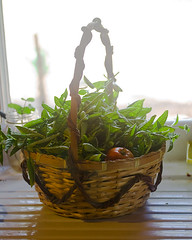 Ah yes, lots of basil these days. I planted several varities including thai, lemon and cinnamon as well as the standard genovese. I’ve got a bit drying but mostly I’ve been making gobs of pesto. Mostly I’ve eaten it as I make it but I’ve frozen a bit too. Still have lots more to blend up for winter meals. I absolutely love this stuff. Not only are the plants absolutely beautiful with their abundant, lush leaves but they grow so easily.
Ah yes, lots of basil these days. I planted several varities including thai, lemon and cinnamon as well as the standard genovese. I’ve got a bit drying but mostly I’ve been making gobs of pesto. Mostly I’ve eaten it as I make it but I’ve frozen a bit too. Still have lots more to blend up for winter meals. I absolutely love this stuff. Not only are the plants absolutely beautiful with their abundant, lush leaves but they grow so easily.
Technorati Tags:
Food, Food Production, Gardening, Herbs, Homesteading, Living Simply, Permaculture, Pesto, Self Reliance
Rooted in a place
Several weeks ago I finally made the short journey down to see Roger’s place. I’d met Roger this past fall through Ruth Ann and the Cowboy Coffee. It’s funny actually, the first or second time I’d gone into the coffee shop Roger was at the far end with Ruth and Juli and they were dancing and goofing off and it was at that moment that I knew that the coffee shop was going to be my favorite reason to drive into town.
Since then I’ve had some great conversations with Roger and he occasionally mentioned his farm south of town in the foothills of the Ozarks. It was obvious the very first time he told me some of the story of his family and this farm that this was a connection to the land far deeper than the norm. Of course, really, that’s not saying much is it? We live in a time when the norm seems to be constant migration with little to no connection to the land. Family farms and land based living has declined steadily for many decades. The norm today is the suburban subdivision or a place in the city. There are rarely any kind of long term connections formed to these places as they are simply meant for relatively short term occupancy by any one family, often 15 years or less.
Roger and his family have woven a different kind of story which is based on an intimacy with a landscape that is hard to really understand. His family first began living there in the mid 1800s and have been there ever since. Roger grew up there and continues to live in a house he built in the 1980s. The house he grew up in, built around the turn of the last century, is a stone’s throw away and is his son’s home today.
On the day of our trip my time was a bit limited so I got the “short” tour. I think we were there for maybe 1.5 hours and having seen what I saw in that time I know that it was the short tour. One could easily spend a day there. Or a lifetime. This is no ordinary place. As we walked and drove around Roger narrated with fantastic detail the various stories of the generations of his family.
The farm is deep down in a valley and feels protected, cradled by the hills. It stays cooler down here. The soil is pretty rocky too though there are quite a few areas which have been cultivated over the years.
We started with the beautiful white two story turn of the century home that he grew up in and then slowly moved further into the landscape and as we went the stories he told went further back in time. There are three springs on the property which, over the years, served as the family’s primary water source. In fact, the proximity to the springs was a primary reason for the location of the homestead. At one of these I bent down and for the first time in my life cupped my hands to drink the sweet water from a cold, natural spring. It flowed from under a tree into the rocky creek gravel. Fantastic.
From there we worked our way down the creek to the original family house which had been cut into three sections and moved from the original location further back which we also saw towards the end of our tour. This was an old, old house. Roger’s grandfather’s bedroom was left as it was when he died many years ago and given the state of the house and lack of windows seemed surprisingly intact. Roger told me of another spring that had been directed to the house using a pipe and showed me the buried tub that had been used to keep fish after they had been caught and before being eaten. In the cold flowing creek just outside the house a very nice bit of water cress was growing and I enjoyed several bites. I’m going to have to see if I can get some of that growing here because it was very tasty!!
Something else that Roger was sure to point out were the trees. So many wonderful trees were growing here! There was a nice mix of very old and young trees as well and the diversity of species was really fantastic. I’d imagine that it would be very interesting to explore the evolution of the land here in much greater detail. Roger knows trees and he knows the trees growing on the farm with great intimacy. In fact, he seems to know every inch of the land which brings me to the heart of this post. While I was in awe of the beauty of this landscape I think it was Roger’s connection to it that really struck me.
To spend an entire lifetime in one place seems very rare these days. That it is such a beautiful place and one that has served as a home for so many generations of a family only deepens an already profound relationship. I cannot really fathom such intimacy with the land. Those of you that know me or that read this blog you know my current adventure trying to co-create this permaculture homestead. I’ve barely been here a year and I already feel more at home. This is a place I spent many of my childhood summers and so there is that connection too. But my childhood memories and my knowledge of my ancestors includes several states and cities and many different yards and homes. There is no long term base for our family.
From the old family house we passed the remains of an old wagon worked our way down and through various pastures and to the creek where there were many beautiful pawpaws growing. Roger relayed the story of the all-day trip to pick-up the wagon from Farmington which, like another story about his grandfather walking to Mine La Motte (20+ miles each way), really gives perspective to life without the combustion engine. It also serves as a reminder of what the automobile has done to change our relationship to the natural world around us. You don’t see many details, smell any honeysuckle, or hear the song of birds when you travel in an air conditioned bubble at 60 mph.
The creek served as a place to swim, play and get cleaned up and I can’t imagine a better place to spend an afternoon. As we crossed the creek on foot to see the steep hillside opposite of the field I was again reminded of the amazing diversity of species in the area. I think if I were to spend much more time there I would begin getting a sense of the patterns and history of the plants and trees but in such a short time it was too much to take in. On the far side of the field away from the creek was a pine covered hill and small pond, an ideal area for blueberries I’d imagine. It was around this time that we circled back and my tour ended.
I look forward to another trip down there when I have more time to take in the details without feeling so overwhelmed. As I come to the end of this post I can’t help but feel that I’m missing something. I think when you’ve had a glimpse of something like this, something special with a history you also leave with questions. History is a story and an old homestead such as this feels like a window or, more accurately, a door that can be stepped through. Having Roger there to tell the history no doubt deepens the appreciation and understanding even as the stories evoke a sense of the unknown. In a strange way it is also a very direct connection to the ongoing flow of history. Roger is a part of it. We all are.
“Time is an enormous, long river and I am standing in it just as you are standing in it. My elders were the tributaries and everything they thought and every struggle they went through and everything they gave their lives to, every song they created and every poem they laid down flows down to me and if I take the time to ask, and if I take the time to see, take the time to reach out I can build that bridge between my world and theirs, I can reach down into that river and take out what I need to get through this world.”
–Utah Phillips from the song Bridges
A day's harvest
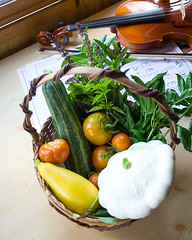 Even with the troubles I’ve had with this year’s garden I’m still pulling in a nice harvest. I planted at least five varieties of all the following: summer squash, tomatoes, peppers, basil as well as several winter squash and melons. Most are producing at least something, some more than others. If I can continue to keep the rabbits out I should have a decent harvest of greens this fall and will be planting a good bit in the greenhouse.
Even with the troubles I’ve had with this year’s garden I’m still pulling in a nice harvest. I planted at least five varieties of all the following: summer squash, tomatoes, peppers, basil as well as several winter squash and melons. Most are producing at least something, some more than others. If I can continue to keep the rabbits out I should have a decent harvest of greens this fall and will be planting a good bit in the greenhouse.
Technorati Tags:
Food, Food Forest, Food Production, Forest Gardening, Gardening, Herbs, Homesteading, Living Simply, Permaculture, Self Reliance
Permaculture Workshop Series
Are you interested in learning the skills needed to live a more self-sufficient and sustainable life? Concerned about the economy, climate change, and peak oil? Ready to get your hands dirty?
Come for an introductory workshop to our permaculture homestead! The workshop will include a discussion of the basics of permaculture to be followed by a tour of our site for a first hand view of how the principles look when implemented. We’ll see and discuss:
Some of the principles of permaculture design that will be discussed:
Time and space permitting we may also watch a couple of short videos. Bring a sack lunch. If there is an interest in learning more beyond this introduction we may setup a series of workshops.
When: Saturday, September 12th, 10am-3pm
Location: 6 miles north of Fredericktown, we’ll give you directions when you sign up!
Cost: Free!
If you are interested in learning more or would like to reserve a spot leave a comment or email geekinthegarden at gmail dot com
Technorati Tags:
Food, Food Forest, Food Production, Forest Gardening, Forests, Permaculture, Self Reliance
Learning from Nature with Sheet Mulching
This is the fifth article in an ongoing series that I’ve written in our town’s alternative paper, the Madison County Crier. The series is intended to be an introduction to permaculture, often illustrated by examples taken from our homestead. When possible I’ve also made it a point to link in to the potential for a permacultural approach to town and community life as well as the prospects for easing our town’s transition into this new future we have before us.
In my last article I discussed relationships as they exist in garden guilds and in town communities such as Fredericktown. Much of permaculture is about how we design relationships into a site so that things such as plants, animals and buildings work better together and so require less energy input from us. This week I thought I’d focus on a very practical hands on task that, while seeming very simple to us, enables complex natural processes which increase the health and diversity of our garden soil: sheet mulching.
Walk out into any mature Missouri woodland of diverse trees and dig our hands down into the soil and you will find fantastic fertility. At any moment woodland soil is full of organic matter in the process of decay. Fungi and soil microbes are constantly breaking down leaves, sticks and any other “dead” matter that has fallen to the forest floor. According to Jack Kittredge in the Spring 2002 issue of The Natural Farmer:
… it is hard to overestimate the importance of mushrooms in forest life. Their mycelia form a complex forking network of interwoven strands of cells that grow beyond the immediate tree’s root zone, extending, in extreme cases, over many acres. The mycelial content of topsoil in a Pacific Northwestern Douglas Fir forest has been estimated to be as much as 10% of biomass! Each mycelium gives off
enzymes which unlock organic compounds in the surrounding matrix, releasing carbon, nitrogen, and other elements that are then absorbed and concentrated directly into the network.
Modern agriculture, as it has grown from small family farms to massive acreage industrial farms, has taken an approach which relies on fossil fuel-based chemicals for fertilization and the removal of “pests”. It is an approach which has decimated the natural fertility of complex soil ecosystems. Even small scale vegetable gardening is most often accomplished with tilling which greatly disrupts the natural microbial layers found in the soil. Opening up the bare soil to the direct sun and wind is not only destructive but is an open invitation to weeds and the need for more work or the use of chemicals.
The no-till method of gardening using heavy layers to form a thick sheet mulch creating conditions very similar to a forest floor: carbon rich, shaded, cool and moist. Pull back a section of sheet mulch which has set for six months or more and you will find a great abundance of earthworms, far more than were there before the mulch. A close examination of the newspaper or cardboard will also reveal many patches of intricate white threads, the mycelium of soil fungi which have been busy breaking down the carbon. The soil is so thoroughly tilled by the earthworms and the crumb structure improved that you will usually be able to easily push your fingers deep into the ground with little effort.
Now, let’s get down to the how-to. Sheet mulching is incredibly easy but may require a bit of planning to save or collect the materials needed. You’ll need lots of newspaper, cardboard, or both. Nothing with waxy coatings and bright colors such as many of the advertisement sections of the paper. We want basic newsprint and basic brown cardboard. Ask around the businesses in town and they are often glad to have someone take it away. The amount needed is determined by the size of garden space. The other ingredient is something like straw, leaves or wood chip mulch. Straw works very well because it will last a full year, won’t blow around and looks pretty nice. Wood chip mulch also works well but cedar and pine may increase the acidity of the soil avoid those woods as well as anything which is treated. Leaves tend to blow around and don’t look as nice. If you have lots of leaves use them but top off with straw or wood mulch for a tidier appearance. Aged manure or compost can also be used and will speed the process up a bit but are not essential ingredients.
Step one is to water the area to be mulched. I often plan to do it the day after a rain. Basically, the ground just needs a good watering as you might do if you were watering a garden or lawn. If you have compost or manure spread it over the area to be mulched in a layer three inches or less. Next comes the cardboard or newspaper which should be laid down so that it overlaps a couple inches on each side. Don’t spread too thin. If using newspaper open it at the fold then lay it down. If the layer is too thin it will break down more quickly and may not last a full year which is the goal. Follow the cardboard/newspaper layer with straw, leaves, or wood chip mulch which should be laid down in a layer of about three inches. Give this layer a light watering. Done.
Laying the mulch should be done in spring, summer or fall. I think spring or early summer is best. You can mulch directly over hard compacted grass without mowing or any other preparation but this area won’t be ready for planting right away. In areas which have been mulched for at least 4 to 5 months the soil is often improved enough to plant in fairly easily. This spring I’ve been working in a bed which was mulch last summer and the soil is greatly improved. The cardboard is very well rotted and can be easily pushed through with a small hand shovel for putting in plants and seed potatoes. For direct planting of seeds I can easily clear away a row or area with hoe or hand shovel.
When we sheet mulch not only are we using “waste” materials such as newspaper and cardboard, we will find that the need to water and weed are greatly reduced. Not only are we more efficiently using resources and saving ourselves time but we are greatly improving the stability and health of our soil.
Technorati Tags:
Community, Economic Collapse, Economic Depression, Economy, Energy, Energy Conservation, Food Production, Gardening, Global Depression, Great Depression, Homesteading, Living Simply, Natural Resources, Permaculture, Recession, Self Reliance, Small Town Life
Permaculture and critters
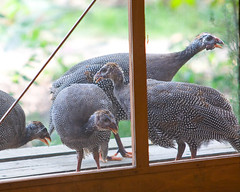 Something I’ve been noticing and thinking about recently is the natural movement and roles of critters in our evolving permaculture landscape. The homestead is starting to feel a bit like an ecosystem. By that I mean that after being here more than a year I’m starting to feel more at home. I’ve had time to settle in, observe, think, and participate. As I slowly design and work the site I continue to learn not just about the energy flows such as water, wind and sun but also the energy and work of the critters as they do their thing.
Something I’ve been noticing and thinking about recently is the natural movement and roles of critters in our evolving permaculture landscape. The homestead is starting to feel a bit like an ecosystem. By that I mean that after being here more than a year I’m starting to feel more at home. I’ve had time to settle in, observe, think, and participate. As I slowly design and work the site I continue to learn not just about the energy flows such as water, wind and sun but also the energy and work of the critters as they do their thing.
The chickens have been here for four or so months and now that I’m down to 15 in the main flock they are much more manageable. Three more (fairly aggressive roosters) are currently in a chicken tractor and will remain until we butcher them. The main flock is released to mostly free range from noon till sunset. I have a few strategically placed fences that don’t enclose them but encourage them to stay in certain areas and out of others. By 5 or 6 pm they have moved beyond my barriers and can be found anywhere and everywhere. Once the main chicken run has had time to recover I’ll put them in there 3-4 days a week. But I prefer to have them integrated. I want integration. I like to look out and see them taking a drink from the little water garden. The squash they tend to get into also happens to be free of squash bugs whereas the other patch has had gobs of squash bugs. It’s a balance.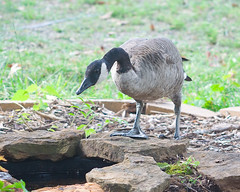
As I’ve commented before the guineas are my favorite. While I may not get many eggs from them they are constantly on bug patrol and while doing so they leave their manure but NEVER disrupt mulch or my plants. If it works out that I can keep track of their eggs then that will be a great bonus.
We’ve also got a Canadian Goose that has been visiting most of the day for the past week or so. She’s made herself right at home with the chickens and seems to enjoy hanging out by the water garden and around my cabin. Fine by me! She eats alot of grass and when she’s not eating she’s preening herself which means she’s leaving little feathers here and there as well as a bit of manure. As with all of the above, she belongs here. She fits. She does her work and leaves behind her nitrogen rich soil amendments. It’s got me thinking about the possibilities of keeping ducks or geese. Will need to investigate that a bit further.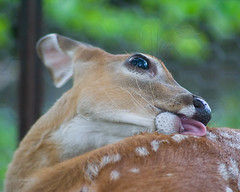 Last but not least is Petunia who has gotten her freedom this week. She comes and goes as she pleases and is being weaned off of the bottle this and next week. It has only been a couple days but she seems comfortable as she cautiously explores the area a few hours at a time. Before long she’ll be spending more time away than here and eventually I expect that her visits will become the exception to the rule. Having raised her I feel pretty confident that I can take care of a goat or two and will be doing a good bit of further research on that. One thing I want to get started on a year in advance of any goat keeping would be planning proper goat forage. As with the chickens it makes more sense to grow the food on site rather than spend money and waste energy importing it from feed stores. Actually, that’s something I’ll need to work on for the chickens as well. I’ve got a list of things I want to get planted, mostly perennials that should help out. We’ve also got gobs of honey locust trees so I’ll be harvesting those seed pods soon and will be feeding that as a supplement over the winter.
Last but not least is Petunia who has gotten her freedom this week. She comes and goes as she pleases and is being weaned off of the bottle this and next week. It has only been a couple days but she seems comfortable as she cautiously explores the area a few hours at a time. Before long she’ll be spending more time away than here and eventually I expect that her visits will become the exception to the rule. Having raised her I feel pretty confident that I can take care of a goat or two and will be doing a good bit of further research on that. One thing I want to get started on a year in advance of any goat keeping would be planning proper goat forage. As with the chickens it makes more sense to grow the food on site rather than spend money and waste energy importing it from feed stores. Actually, that’s something I’ll need to work on for the chickens as well. I’ve got a list of things I want to get planted, mostly perennials that should help out. We’ve also got gobs of honey locust trees so I’ll be harvesting those seed pods soon and will be feeding that as a supplement over the winter.
The more I think about it the more I realize that what I’m doing here is trying to create a natural forage system for all of us that live on the site. I suppose that’s the whole point isn’t it? To create a perennial system that feels and functions like a natural ecosystem. Such a system, once “established,” does not require gardening so much as harvesting which means less input of time, energy and money.
Technorati Tags:
Cabin, Food, Food Forest, Food Production, Forest Gardening, Gardening, Homesteading, Living Simply, Permaculture, Chickens, Guineas
Thoughts on the garden
This year’s garden, the second year in this location, has been a bit of a disappointment. On a positive note there is the soil improvement. While soil building does not happen over night especially when high nitrogen manures are not added, I’m definitely seeing improvement thanks to the cardboard and straw. There’s no doubt that the earthworm population has greatly increased as has the overall abundance of fungi and microbial life. Now that I’ll be adding in a bit more nitrogen thanks to the chickens and lots of comfrey that starting to establish well I should be able to give it a bit of a boost next year.
The downside of this years garden has been the actual harvest. I started off with a huge mistake which was fencing that was not rabbit proof. The little shits spent the spring eating my greens and onion tops. So, no real onion harvest to speak of and the greens eventually came on to provide an okay crop. I’ve since gotten the fence to about 90% rabbit proofness though they can still get in. Will have to add a bit more of the chicken wire to the last bit of fence that only has up to 12". They can jump over that 12" and through the welded wire though it is pretty obvious that my rabbit visitations are greatly reduced. Lesson learned and next year’s production should be much better.
Another problem was the start. We had such a wet spring that I started lots of stuff too late. Squash, melons, cukes, corn and a few others. Those things that did get in were so flooded that they struggled. The sugar peas died and many of the tomatoes barely made it. The potatoes and sweet potatoes have done very little. The cukes, which have looked okay and have had quite a few flowers, have, thus far produced only one fruit. Same spot as last year where they produced gobs. Even with the late start the various squashes have produced… not great but they are producing. More coming from them I’m sure. The melons have fruit though they are slow. The corn was demolished by rabbits and next year will be well fenced. Lots more squash bugs this year, probably due to the greatly increased number of squash plants!
The peppers have fruit on though they were late to the game. Probably due to the late start and very cool July?
Pests such as tomato hornworm and flea beetles have been a huge problem. The flea beetles turned the eggplants leaves into a network of holes and something else finished them off, not sure what. The hornworms have been all over the tomatoes since early July and have decimated them. Even so I’ve gotten quite a few tomatoes but not enough to can which is a shame because I had well over 60 plants out there. I certainly got my money’s worth in terms of the $8 spent on the five varieties of heirloom seed but probably only 10 or 20% of the crop I would have had without the hornworms. I’ve also had a bit of blight or bacterial wilt, not sure which.
The four varieties of basil have been fantastic and the zinnias and cosmos filled out pretty well. I’m going to have to plant lots more color and scent next year to better camouflage the tomatoes. This year I used the fence as a trellis and am thinking that was a part of the hornworm problem. If I use the fence again next year I’ll be certain to have plenty of flowers along the outer side of the fence which is the plan regardless. I’m transplanting lots of sweet coneflower that is coming up everywhere to the outside of the fence and will be transplanting purple coneflower as well. The gaps will be filled in my basil, zinnia and cosmos. I’d like to have twice the flowers next year.
So, yeah, not the best year for the kitchen garden. I feel pretty confident though that the soil improvements will start to show and of course the rabbit proof fencing will make a huge difference next year. Really though, the garden is too big for one person. My keyhole beds by the cabin are enough to feed me, at least in terms of leafy greens and probably even peppers and tomatoes. Will try a few things differently next year. Looking forward to the fall garden and trying out the greenhouse for a bit of season extension and winter greens. The tomatoes in the greenhouse are thick and green, so far untouched by hornworms though also not producing many blooms or fruit. Not sure why? Wondering if those free windows have some sort of uv glaze that is inhibiting fruit production? Will be curious to see how the greens do in there.
Living and learning…
Technorati Tags:
Cabin, Food, Food Forest, Food Production, Forest Gardening, Gardening, Homesteading, Living Simply, Permaculture, Self Reliance
Guineas!
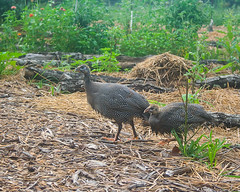 I’m really loving these guineas! Not only are they beautiful birds but they are fantastic in the garden. In the mornings they follow me into the fenced kitchen garden and spend the day in there eating bugs. Unlike our chickens the guineas do no damage to the plants nor do they throw mulch everywhere. They just putter around eating bugs. I’m fairly certain that I’ll be adding another five or ten to the flock next summer.
I’m really loving these guineas! Not only are they beautiful birds but they are fantastic in the garden. In the mornings they follow me into the fenced kitchen garden and spend the day in there eating bugs. Unlike our chickens the guineas do no damage to the plants nor do they throw mulch everywhere. They just putter around eating bugs. I’m fairly certain that I’ll be adding another five or ten to the flock next summer.
Technorati Tags:
Cabin, Food, Food Forest, Food Production, Forest Gardening, Gardening, Homesteading, Living Simply, Permaculture, Self Reliance, Guineas,
Rain-filled Swale
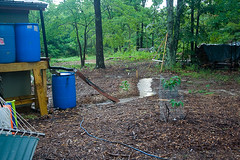 We’ve just had our first real rain since I put in the swale and it has worked exactly as planned. It filled up to level and then slowly out the end furthest from the cabin. I’m looking forward to putting in more and wish I’d made this more of a priority. I am very curious to see what kind of effect this small swale has on the surrounding soil. Even such a small swale, 15 feet in length and just 8 inches deep counting the berm and 15 inches wide collects a good bit of water!
We’ve just had our first real rain since I put in the swale and it has worked exactly as planned. It filled up to level and then slowly out the end furthest from the cabin. I’m looking forward to putting in more and wish I’d made this more of a priority. I am very curious to see what kind of effect this small swale has on the surrounding soil. Even such a small swale, 15 feet in length and just 8 inches deep counting the berm and 15 inches wide collects a good bit of water!
I’ll be putting another swale in 20 or so feet further up the hill which will likely be a bit longer, deeper and wider. Beyond that I have a few thoughts about other potential swale locations in the main garden and orchard areas.
On another water harvesting note, both rain barrels are full so that’s another 110 gallons and I’ve got the six barrels I need to set up the collection system behind the cabin. Now I just need to buy the pvc and plumb it all together.
Technorati Tags:
Cabin, Food, Food Forest, Food Production, Forest Gardening, Gardening, Homesteading, Living Simply, Permaculture, Self Reliance, Swale, Water Harvesting
Return to the Local
This is the second article in an ongoing series that I’ve written in our town’s alternative paper, the Madison County Crier. The series is intended to be an introduction to permaculture, often illustrated by examples taken from our homestead. When possible I’ve also made it a point to link in to the potential for a permacultural approach to town and community life as well as the prospects for easing our town’s transition into this new future we have before us.
In a recent article I defined permaculture as permanent agriculture or permanent culture which puts forth a system of designing food producing ecosystems which produce more food but require less energy. Permaculturalsystems, as sustainable systems, are designed to be largely self-contained in that once set up they do not require inputs of energy from outside systems. These concepts of self-reliance or self-contained sustainability are also aspects of our town and the surrounding region.
Let me offer two examples: honey and eggs. On our permaculture homestead we’ll be setting up bee hives as well as a chicken coop. Not only will we benefit from the main products of honey and eggs but we will also see many other benefits from this more complete ecosystem. For example, our bees will increase the pollination of our fruit trees and garden plants resulting in more produce and we’ll have beeswax for making candles. The chickens will increase the productivity of our garden and orchard with their manure as well as their control of insects that might otherwise eat our produce.
We’ll likely have more eggs and honey than we can eat which means we’ll be able to share or sell to family, friends, and neighbors. They benefit from fresher food produced with no chemicals and harvested ripe with no need for preservatives. We all benefit in that local energy and resources are being used for production and consumption within our community. This is opposite of the oil-based global economy which places no importance on keeping production and consumption local. When we go to Wal-Mart or other big box stores for our food not only are we are sending our money out of our community, we are allowing ourselves to become dependent on others for our most basic survival needs.
With every day we increasingly see the dangers of this system. Produce which is harvested before it is fully ripe so that it can be shipped across country before it rots is not as tasty or healthful as produce which is harvested at full ripeness and eaten two hours later. Even worse, food produced by large scale industrial agribusiness is tainted with a variety of chemical pesticides, fertilizers, insecticides, waxes and recently, sometimes bacterial contaminates such as salmonella.
The problem is not just our food production. We hear about banks and businesses which are too large to fail and yet they are failing, bringing the entire global economy into a depression. Such a system is not sustainable and the more energy and money we spend trying to prop it up, the less energy and money we will have to develop our local alternatives which we control directly. It is a problem perpetuated not only by government bailouts but by us as well. We failed to maintain our ability to take care of ourselves and one another in our communities. In the last century we chose a way of life that emphasized good deals on gizmos and hyper consumption which was based on cheaper production in China and elsewhere which meant jobs lost in the U.S. Even worse, this entire global economy is based on cheap fossil fuels, primarily coal and oil. We have likely reached a peak in production of oil and are now realizing that never-ending economic growth is impossible. The ponzi schemes of Wall Street created the illusion of growing wealth throughout the past 20 years but we know now that it was an illusion and it is now collapsing before our eyes.
While we may not have any control of the global economic system we can work to build our local economy which we can control. Everyone reading these words can grow some of their own food. In the summertime we can buy local food at the farmers markets which we can eat fresh and preserve for winter meals. Every single tomato grown and consumed locally adds value to the health and vitality of our community. Taking greater control of our lives and building a more secure, sustainable future starts with me and with you.
Technorati Tags:
Community, Economic Collapse, Economic Depression, Economy, Energy, Energy Conservation, Food Production, Gardening, Global Depression, Great Depression, Homesteading, Living Simply, Natural Resources, Permaculture, Recession, Self Reliance, Small Town Life
Living the life...
The permaculture life that is. Most of my thoughts this past year have been centered on permaculture and how I can use it in my life here. I’ve read through various permie books and am working through the Designer’s Manual now. Next on the list would be the two volume Edible Forest Gardens by Dave Jacke and Eric Toensmeier. I’ve also spent a good many hours watching permie related video and browsing through ooddles of permie websites and many beautiful flickr sets. All of these have been very inspiring and full of useful information. I don’t have a PDC (Permaculture Design Certificate) and am not sure if I ever will though I certainly would like to. Actually let me come back to this subject in a minute.
I’ve been acquiring the information and have been working to put to use. I’ve got a long way to go but I’m pretty happy with what we have done thus far. As I commented in the last post the food forests are steadily coming together though I’m still experimenting, learning and thinking about guild design as well as arrangement around buildings and a variety of permaculture design principles. I suppose that is to be expected as this is, no doubt, a never ending process.
The newest additions arrived this past Wednesday and are all in the ground. Two paw paws and three juneberries right around my cabin to fill in the fairly large sunny spots on the north, east and southwest side of the cabin providing me with food and eventually a good bit of summertime shade. They won’t actually shade much of the building itself as it is already mostly shaded, but they will shade the area all around and should provide a good bit of overall cooling. They’ll also get the benefit of a small swale system fed by the hill and my rain barrel run-off.
For those that my not be familiar, pawpaws are in the custard apple family and have an oblong yellowish banana flavored fruit with the consistency of custard. I have yet to meet a fruit I don’t like and I’m sure I’ll love these. Very pretty too. The juneberry is one of the earliest to bloom in the spring and apparently has fantastic fall color. Most importantly these large bushes (one of the two varieties I’ve got is 12-15 feet tall, the other 8-10 feet) have berries very similar to blueberries. I don’t know how much fruit they get but if is as much as a standard blueberry that will make me happy. I did get three more blueberries which will be planted in the blueberry patch in the main food forest and brings us up to 8. Between those and the Juneberries think we’ve got a good start on that particular flavor of berry!
One other note about this new area of food forest around my cabin. I made a simple a-frame level and have marked off the contour for a swale to collect water from the rain barrel overflow. Right now it is just a single barrel but I now have six barrels and will be picking up the pvc I need to plumb it all together soon. The overflow will go to this swale on the north side of the cabin and will take the water away from the house and slowly down the hill towards the juneberries. I’ll also be putting in a swale 10 or so feet higher up on the hill to collect water before it gets to the pawpaws.
Now, back to the PDC. I have mixed feelings about this. Essentially it is a certificate that requires a course of 10-15 days. I thought about doing it 10 or so years ago but didn’t. I’m thinking about it again. But I can’t quite justify the cost. I have little doubt that I’d learn something in the experience as a good teacher will very likely offer insights that are not always clear in the text. But I don’t know that I’d ever actually use the PDC in the sense of charging someone for a consultation or garden design. Maybe I would but that is not my primary interest. My primary interest is in learning for the development of our site as well as to share the information in my community. In my view permaculture is something that may prove essential not only to the survival of our species, but also to our ability to begin undoing the damage we have done. Charging people to help them implement or use permaculture isn’t something I’d feel comfortable doing.
Sharon Astyk, one of my favorites, wrote an excellent article regarding permaculture, specifically the presentation of it to the public. There are many pages of responses of folks that are also thinking about how permaculture is shared (or sold) with (to) the public. Until now it has been an “alternative” to what is mainstream, both in terms of content as well as the culture of those practicing and advocating. But if it is to become the new way of designing and organizing our homes and communities there are a few barriers that will likely need to be addressed by the current permie movement.
The question Sharon asks (I’m paraphrasing) is, is permaculture to remain largely in the domain of alternative subcultures? I’m pretty sure that she is speaking of the historical tendency of practitioners seeming to be hippy-punk-green-anarcho leftish, dreadlocked, barefooted, vegans. There are a variety of ways that the folks practicing and advocating permaculture might be perceived as being different from the mainstream and for some that perception of alternative identity might be an impediment to acceptance. Although it does seem silly, or even a bit bizarre, I suppose that in the context of a workshop or class, if one were surrounded by folks that seemed noticeably “different” it might be a barrier.
Another barrier that I would add (not one of Sharon’s points but brought up as a point in several of the comments to her article) concerns the high priced PDCs. While I see the value of the PDC to ensure that those specifically selling design services are indeed qualified, I do think anyone should be able to use the word to describe what they are doing if they are not specifically selling their time as permaculture designers. I don’t think anyone making a real effort to follow the practices in their personal work or even those coming together to share in larger community projects should hesitate to use the term. I’ve been writing a series of articles for the Madison County Crier about permaculture and how we are using it at our homestead as a specific example of how the design principles translate in real life application. (Actually I’ve been meaning to post those here for quite some time and will start today.)
The basic point is that there is a bit of confusion about who and how the word “Permaculture” may be used by those that don’t have a PDC but who practice it and would like to share it with others. I suppose what it comes down to is common sense communication. In addition to the above mentioned articles, later this summer or early fall I plan to do a series of workshops for interested local folk. I’ll be having them out to our site so that I can discuss, share and illustrate (teach) permaculture using what we’ve done as an example. I won’t be charging anyone nor will I be presenting myself as a “certified” permaculturist. Rather, I’ll make a book list available as well as recommended websites. We’ll probably watch a few videos and then spend a few hours relating the books to the implementation they can see.
The times we are in require that folks learn and transition to a new reality. Permaculture, whether it is called ecological gardening or forest gardening or whatever is an important part of this transition and should be available to anyone. If I can help spread the word I will.
Technorati Tags:
Cabin, Food, Food Forest, Food Production, Forest Gardening, Gardening, Homesteading, Living Simply, Permaculture, Self Reliance